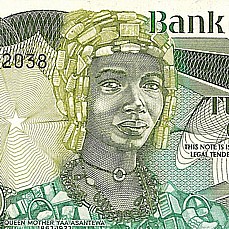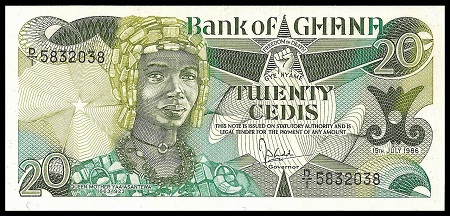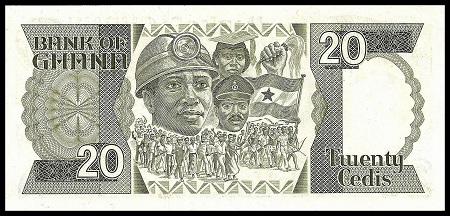GHANA
YAA ASANTEWA–QUEEN MOTHER

The British Gold Coast Colony is now the African nation of Ghana, which achieved independence in 1957. But the Gold Coast has had a long history of European invaders with aspirations of abusing the land and people who inhabited it. Beginning with the Portuguese in 1471, but they were soon followed by other Europeans from Denmark, Netherlands, England, Sweden, Prussia, and other countries. They all had their sights set not so much on discovering this new world as much as they were in Ivory and, of course, gold and slaves to help them obtain it. There were several battles between the European nations and the inhabitants of the Gold Coast as to who would control the area and get the spoils of the war. After the British had established themselves as the predominant European nation in the area, they had to contend with the inhabitants. The main opposition to British control was from the Ashanti people, who fought in four wars with the British, but in the end the British won out and established the Gold Coast Colony on July 24, 1874. The British burned down the Ashanti capital Kumasi, and raided the king’s palace. By 1877, the British established the capital of their colony within the city of Accra.
In 1884, the Berlin Conference established a new set of rules concerning the African Continent. While there was some good that came from this conference, such as prohibiting international slave trade, and setting up the Congo Free State (known as The Democratic Republic of the Congo today), and setting up rules for other nations taking control of areas in Africa, there was little consideration given to the people of Africa when the Berlin Conference divided up Africa into 50 European colonies, which gave the Gold Coast to Britain. This division of Africa did not take into account any of the cultural aspects of the people, languages, or tribal affiliations. Thus the Race for Africa was on and explorations into the interior were made to obtain treaties with the locals, by force if needed, to establish the colonies according to rules established by the Berlin Conference.
In 1888 the Ashanti King Nana Ageyman Prempeh I (Prempeh I) ascended the throne of the Golden Stool at the age of 16. Yaa Asantewaa’s brother was the past Ashanti King, and she used her position to place her son onto the throne of the Golden Stool. The Golden Stool had, according to legend, been sent from the heavens to the first Ashanti King Osei Tutu. This stool served as the throne of all subsequent kings and was thought to house the spirit of the Ashanti Kingdom. Prempeh I had been a thorn in the British government’s side. He had fought against the British invasion and occupation, rejected offers from the British to place the Ashanti Kingdom as a British Protectorate, and had strongly maintained that his kingdom should be independent, but would maintain friendly ties with the Europeans.
In 1896, the Ashanti people of the Gold Coast had been taken over almost entirely by the British. In order to maintain their dominance, the British exiled Prempeh I to the Seychelles, a group of islands in the Indian Ocean. Then in 1900 the British demanded the Golden Stool from the Ashanti people. Neither Prempeh I nor the Ashanti people did not resist as they saw the exile as better than a war with the British and the possibility of losing the stool to them. The Ashanti let their king go, and hid the Golden Stool from the British.
But even though the British had removed the Ashanti king, the people still were not as compliant as the British wanted them to be. So, on March 25, 1900, in an effort to gain further dominance over the Ashanti the British Governor of the Gold Coast, Sir Frederick Hodgson, demanded to stool from the Ashanti. Hodgson saw himself as the current leader of the Ashanti people, and assumed that his being able to sit on the Golden Stool would bring the Ashanti into compliance. But Hodgson hadn’t fully understood the significance of the Golden Stool, and he hadn’t counted on Yaa Asantewaa, the Queen Mother of the Ashanti, who had been instrumental in obtaining the throne for her son.
The very suggestion that a European should sit on a stool that descended from the heavens and embodied the spirit of the Ashanti was simply too much. The men of the Ashanti people did not give in to Sir Hodgson’s request and kept the location of their beloved Golden Stool secret. The men later held a meeting to decide what to do about the British. Many of the men were afraid that the British were too powerful and did not wish to fight against them. Yaa Asantewaa, who as Queen Mother was present at this meeting, was angered by their fear and despair as much as she was angered by the demands from Sir Hodgson for the Golden Stool. Yaa Asantewaa berated the men of her people and accused them of being cowards for not standing up more to the British. Yaa Asantewaa told the Ashanti men that if they would not go forward against the British, then she and her fellow women would. Her speech emboldened the men and soon she led a military force headed up to fight the British, and preserve the Golden Stool.
Yaa Asantewaa and other Ashanti leaders commanded attacks upon the British who were combing the forest for the Golden Stool. The British retreated into their offices in the town of Kumasi, which they quickly fortified against the Ashanti warriors. The Ashanti settled in for a long siege. A relief of 700 soldiers came in June, but by then, the Ashanti had cut off most supply lines and telegraph lines. Hodgson and his party in Kumasi were in poor health, and an evacuation took place which let Hodgson and his wife escape. There remained a contingent of several men, who were not going to last too much longer against the Ashanti siege.
When Hodgson returned to Accra, a force of 1,000 led by Colonel James Willcocks, men was sent to rescue the party at Kumasi. Colonel Willcocks had a difficult time reaching Kumasi, suffering greatly from skirmishes with the Ashanti warriors in the jungles and from trying to maintain his supply line through Ashanti Territory. Despite his troubles, Colonel Willcocks managed to storm Kumasi on July 14, 1900 and relieve the beleaguered defenders who were getting ready to surrender to the Ashanti. Now fully in control of Kumasi, Colonel Willcocks sent out contingent to attack neighboring towns and hunting down the warriors who were still acting as guerilla fighters in the forest. Colonel Willcocks’s successes in saving the British at Kumasi and defeating the Ashanti won him a promotion to Brevet Colonel.
The battle was over, but the Ashanti saw themselves as the victors because they saved their Golden Stool from the grips of the British Governor, and thus preserving their communal spirit, and they continued to operate autonomously while under British Occupation. Soon after, Yaa Asantewa was captured and was also exiled to the Seychelles. In 1902 the Ashanti finally gave into some British demands and became a protectorate. The Golden stool however, remained an elusive prize, and the British continued their search for the Golden Stool’s location until 1920 when a band of workers discovered it and robbed the stool of its gold plating, rendering it useless and destroyed in the eyes of the Ashanti people. Once the workers were discovered, they were brought in front of an Ashanti court which levied the death penalty to all the workers. British interference saved their lives by commuting their sentence to exile.
By 1924, the British saw that their grip on the region was sufficiently strong to allow those exiled to the Seychelles to return. Yaa Asantewa had passed away on October 17, 1921 but her son Prempeh I, stripped of his title, was able to return on September 12, 1924 along with fifty-four others. Prempeh I lived as a private citizen until 1931.
Yaa Asantewa is fondly remembered as a patriotic leader and a school and museum have been erected in her honor. Her portrait was placed on the 20 Cedis banknotes which were issued in 1984 and 1986.

